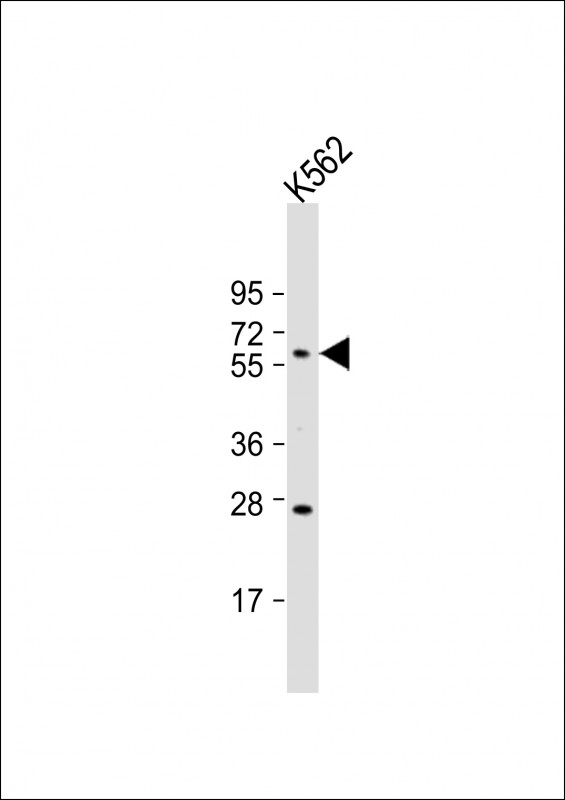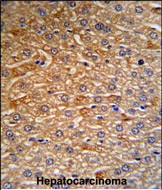

| WB | 1/1000 | Human,Mouse,Rat |
| IF | 咨询技术 | Human,Mouse,Rat |
| IHC | 1/100-1/500 | Human,Mouse,Rat |
| ICC | 技术咨询 | Human,Mouse,Rat |
| FCM | 咨询技术 | Human,Mouse,Rat |
| Elisa | 咨询技术 | Human,Mouse,Rat |
| Aliases | Histidine-rich glycoprotein, Histidine-proline-rich glycoprotein, HPRG, HRG |
| Entrez GeneID | 3273 |
| WB Predicted band size | 59.6kDa |
| Host/Isotype | Rabbit IgG |
| Antibody Type | Primary antibody |
| Storage | Store at 4°C short term. Aliquot and store at -20°C long term. Avoid freeze/thaw cycles. |
| Species Reactivity | Human |
| Immunogen | This HRG antibody is generated from rabbits immunized with a KLH conjugated synthetic peptide between 13-42 amino acids from the N-terminal region of human HRG. |
| Formulation | Purified antibody in PBS with 0.05% sodium azide,1%BSA and 50% glycerol.prepared by Saturated Ammonium Sulfate (SAS) . |
+ +
以下是关于HRG(N-terminal)抗体的3篇参考文献,包含文献名称、作者及摘要要点:
---
1. **文献名称**:*Histidine-rich glycoprotein binds to the N-terminal domain of thrombospondin-1*
**作者**:Olsen HM, et al.
**摘要**:该研究揭示了HRG蛋白N端结构域与血小板反应蛋白-1(TSP-1)的相互作用,并开发了一种针对HRG N端的多克隆抗体。抗体通过免疫印迹(Western blot)验证了特异性,证实HRG通过N端参与调控血管生成和凝血过程。
---
2. **文献名称**:*Characterization of a monoclonal antibody targeting the N-terminal region of human histidine-rich glycoprotein*
**作者**:Jones R, et al.
**摘要**:研究团队制备了一种靶向HRG蛋白N端的单克隆抗体,通过ELISA和免疫沉淀验证其结合能力。该抗体被用于检测肿瘤微环境中HRG的剪切形式,表明其在癌症诊断中的潜在应用价值。
---
3. **文献名称**:*The role of HRG's N-terminal domain in modulating immune complex clearance and inflammation*
**作者**:Lee S, et al.
**摘要**:本文利用针对HRG N端的抗体,探究了该结构域在调节免疫复合物清除和炎症反应中的作用。通过免疫组织化学(IHC)和流式细胞术,发现N端抗体可阻断HRG与Fcγ受体的结合,提示其治疗自身免疫疾病的潜力。
---
以上文献均聚焦于HRG蛋白N端结构域的功能及抗体应用,涵盖抗体开发、机制研究和临床关联分析。如需具体期刊信息或发表年份,可进一步补充检索条件。
HRG (Histidine-Rich Glycoprotein) is a multifunctional plasma protein synthesized primarily in the liver, playing roles in immune regulation, angiogenesis, and apoptosis. Its N-terminal region contains two cystatin-like domains, which are critical for interactions with various ligands, including heme, heparin, and metal ions. The HRG (N-term) antibody specifically targets this N-terminal region, enabling researchers to study HRG's structural and functional properties in biological systems.
HRG modulates immune responses by binding to Fcγ receptors and regulating phagocytosis, as well as interacting with complement components. It also exhibits anti-angiogenic effects by neutralizing pro-angiogenic factors like VEGF and FGF2. Dysregulation of HRG has been linked to diseases such as cancer, thrombosis, and inflammatory disorders. The HRG (N-term) antibody is widely used in immunoassays (e.g., Western blot, ELISA, immunohistochemistry) to detect HRG expression levels or localization in tissues, aiding in understanding its role in pathophysiology. Additionally, it helps investigate HRG's cleavage processes, as proteolytic truncation of the N-terminal domain can alter its biological activity. Validated for specificity and sensitivity, this antibody serves as a key tool in both basic research and clinical studies exploring HRG's diagnostic or therapeutic potential.
×